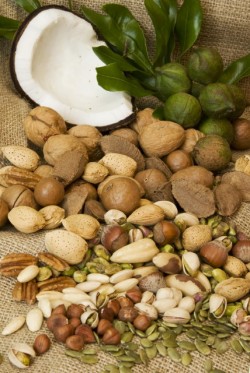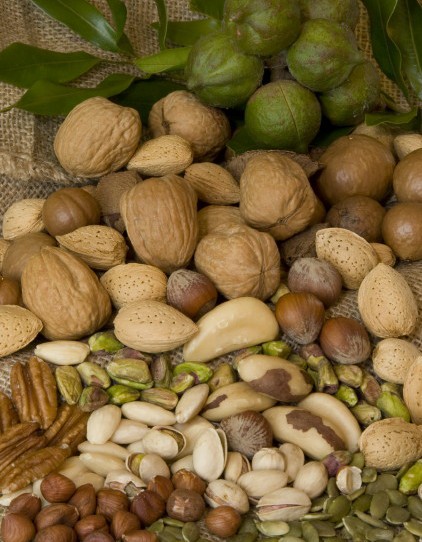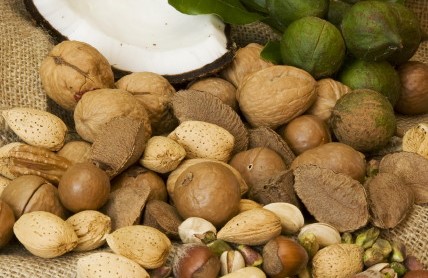Nutrition: Nuts and Seeds
Nutrients
Phytochemicals
How to Enjoy Nuts and Seeds

Nuts and seeds and their butters are a tasty, satisfying, and healthy addition to our diet throughout the year—but they are especially popular fresh or as ingredients in many dishes and baked goods throughout the world during the holiday season. In Germany, for example, it is traditional to serve unshelled nuts for everyone to enjoy during Christmas festivities.
To celebrate the benefits of eating nuts and seeds this season, we would like to share with you some useful information about their health effects—as well as some of our favorite ways to include them in our daily diet.
Nutrients
Large studies have shown that the frequent consumption of nuts is associated with improved cardiovascular health(1). This benefit may be attributed not only to their favorable fatty acid profile of mono- and polyunsaturated fatty acids and dietary fiber, but also to their folic acid, vitamin E, magnesium, copper, dietary fiber, essential amino acid, and phytochemical content. Although the fat in nuts accounts for 80% or more of their total calories, it is often referred to as “good” fat.
In order to function at an optimal level, our body benefits from monounsaturated fatty acids and requires a small amount of polyunsaturated fatty acids, which are also known as essential fatty acids (EFAs) in the form of omega-3 and omega-6 fatty acids (“FAs”). They are crucial to life but our bodies can’t manufacture them, so they must be included in the foods we eat.
Products high in monounsaturated FAs, such as olive oil, avocado, and some nuts and seeds, are both healthy and tasty and may also provide anti-inflammatory effects in addition to their cardiovascular benefits.
Omega-3 FAs have a wide spectrum of potential health benefits including the prevention of some cancers, anti-inflammatory properties and positive effects on mental and cardiovascular health, as well as supporting the maintenance of cognitive functions during aging.
As the table below illustrates, nuts such as almonds, cashews, hazelnuts, macadamias, pecans, and pistachios may be especially good for you, as they contain a high amount of monounsaturated FAs and unaltered omega-6 FAs. Flax seeds and walnuts are particularly good choices because of their high omega-3 FAs. Additionally, sesame seeds are very high in calcium, and Brazil nuts contain large amounts of the mineral selenium, which is a strong antioxidant and cancer fighter. Do not over-indulge on Brazil nuts: two or three a day is sufficient, because chronically high amounts of selenium are toxic to the body(2).
Here is a list of common nuts and seeds and their FAs content(3):
| Name | Fatty Acid Content in 1 Ounce Nuts or Seeds | |||
| Saturated Fatty Acids (g) | Monounsaturated Fatty Acids (Omega-9) (g) | Omega-3 Fatty Acids (mg) | Omega-6 Fatty Acids (mg) | |
| Almonds | 1.1 | 8.7 | 1.7 | 3408 |
| Brazil nuts | 4.3 | 6.9 | 5.1 | 5809 |
| Cashews | 2.2 | 6.7 | 17.4 | 2179 |
| Chestnuts | 0.1 | 0.1 | 14.8 | 123 |
| Coconut | 8.3 | 0.4 | – | 102 |
| Hazelnuts | 1.3 | 12.9 | 24.6 | 2213 |
| Macadamias | 3.4 | 16.6 | 58.2 | 366 |
| Peanuts | 1.9 | 6.9 | 0.8 | 4393 |
| Pecans | 1.4 | 11.5 | 279 | 5828 |
| Pine nuts | 1.4 | 5.3 | 31.6 | 9494 |
| Pistachios | 1.5 | 6.6 | 71.8 | 3729 |
| Walnuts | 1.7 | 2.5 | 2565 | 10761 |
| Flax seeds | 1.0 | 2.1 | 6388 | 1655 |
| Pumpkin seeds | 2.4 | 4.0 | 50.7 | 5797 |
| Sesame seeds | 1.9 | 5.3 | 105 | 5984 |
| Sunflower seeds | 1.2 | 5.2 | 20.7 | 6464 |
While most diets are too low in health-promoting omega-3 and unprocessed omega-6 FAs, they are often too high in unhealthy saturated FAs and processed omega-6 FAs. For that reason, it is a good idea to cut back on foods such as cream, cheese, and high fat milk and to eliminate vegetable oils and margarine as well as products made with them, like dressings and fried and baked products. We use different types of olive oil and occasionally a little butter and even coconut oil for our cooking, baking, and grilling. It works really well and also tastes great.
Reducing unhealthy ingredients in our diet is not always easy to do, because processed omega-6 FAs are widely distributed in the foods we eat at home and in restaurants—in everything from bread to salad dressing. But here is why it is important: while it is believed that our ancestors’ diets provided a ratio of less than 5:1 between omega-6 and omega-3 FAs—which according to scientists is best for our health—the average American diet can contain an unhealthy ratio of 20 or more to 1. A disproportionately high omega-6 to omega-3 FAs ratio in a diet can trigger inflammatory processes and contribute to cancer and cardiovascular diseases.
Whenever possible, choose raw or dry roasted and unsalted nuts and seeds and their butters, as well as avocados, olive oil, and cold water fish (such as herring, sardines, or salmon) as your preferred sources of FAs.
Phytochemicals
In addition to vitamins, minerals, and health-benefiting monounsaturated and omega-3 FAs, nuts and seeds can also contain phytochemicals(3,4). These plant compounds include:
1) phytosterols, which have a similar structure and function as cholesterol and have the potential to lower the body’s absorption of cholesterol; 2) antioxidative phenols, which include polyphenols—a group of plant substances found in foods such as berries, tea, and chocolate; and 3) small amounts of carotenoids—e.g. the vitamin-A precursor beta-carotene. Sesame seeds, sunflower seeds, pistachios, pumpkin seeds, and flax seeds are all good sources of phytosterols, while pecans, pistachios, and walnuts are good sources of phenols. The phytochemicals in nuts may have antioxidative, anti-inflammatory, antiviral, and cancer-fighting properties. It is very likely that the nutrients and phytochemicals in nuts interact, and thus nuts should be eaten as a whole food.
The American Chemical Society reported in 2011 that walnuts contain more antioxidants than almonds, peanuts, pistachios, hazelnuts, Brazil nuts, cashews, macadamias, and pecans(5). They also stated that a person may benefit from the walnuts’ potential health effects by eating only seven nuts a day.
Our recommendation: Depending on your body weight and lifestyle, one or two handfuls of raw nuts and seeds on a daily basis would likely be a sufficient amount of EFAs. Just remember: 1) nuts and seeds are very high in calories, so a small portion is plenty, and 2) it is always best to consume them in their unaltered raw state whenever possible.
And here is more good news: the New England Journal of Medicine(6) reported that those who eat nuts regularly are slimmer than those who don’t.
How to Enjoy Nuts and Seeds
We like nuts and seeds and enjoy eating them whole and raw or toasted as well as including them in different forms in many dishes. Some of our favorite ways to enjoy them are to add small amounts of sliced almonds and shredded coconut to muesli, and to add walnuts and toasted sesame seeds to fresh salads.
If you want to try “toasting” some of your favorite nuts and seeds, dry roast them in a preheated oven of 160-170 degrees Fahrenheit for about 15 minutes, or heat them in a skillet at medium-high heat, stirring occasionally until they are golden brown. It will smell great and be lots of fun for the whole family! Pumpkin seeds are especially good when they start popping and sesame seeds are best lightly browned. Just keep in mind that when you heat nuts or seeds they lose some of their health benefits, despite the fact you might make it easier for your body to absorb some of the nutrients. Store all unshelled nuts and seeds in the fridge to keep them fresh.
Did you know that nuts and seeds stay fresh longer when still in their shells? For the best nutritional value, purchase unshelled, unsalted, and if possible, unbleached nuts. This is because valuable components are lost as nuts are processed. For example, removing their fine skins reduces the amount of the healthy antioxidants you will consume.
We do not recommend eating peanuts—which are actually not nuts but belong to the legume family—for two reasons. First, we try to incorporate raw nuts and seeds into our diet, but you can’t eat peanuts raw. They are always roasted to prevent the growth of mold. Second, hazelnuts and walnuts, our favorites, have a more favorable fatty acid profile and taste better to us. If you want to go with peanuts, buy unsalted, dry-roasted ones and in the case of peanut butter please make sure it does not contain added oil, sugar, and preservatives.
Here are some ideas and suggestions that may help to get you into the mood for eating more seeds and nuts this holiday season and throughout the year:
- Buy raw almonds, walnuts, hazelnuts, Brazil and macadamia nuts, or pumpkin seeds. Depending on how many calories you burn in the course of a day, eat one to two handfuls of your favorite mix.
- Use raw, organic almond butter and roasted hazelnut butter instead of peanut butter—or even cashew or macadamia nut butter if you prefer their tastes.
- Dry roast sesame seeds and try adding them to dressings or sprinkle them over steamed veggies along with olive oil and sliced almonds.
- Add fresh flaxseeds, which have a very mild, pleasant, and nutty taste, to dishes or baked goods. Grind them fine and add them to cereal, smoothies, or yogurts for added taste and nutrition. Fresh flaxseeds have a mild, nutty flavor. If you are not sure if nuts and seeds are still fresh, chew a small amount and if you detect a bitter note or the slightest rancid note, do not eat them. Eating rancid oils and fats can cause health problems.
We hope you will enjoy some of these crunchy and healthy treats during the holidays and throughout the year.
Bon appétit!
Reading Suggestions:
- For more foods that are tasty and good for you, you may take a look at our chocolate article.
- “Uta’s Summary for Your Marathon Preparation. Part III: Nutrition“
References:
(1) Guasch-Ferré M, Bulló M, Martínez-González MÁ, Ros E, Corella D, Estruch R, Fitó M, Arós F, Wärnberg J, Fiol M, Lapetra J, Vinyoles W, Lamuela-Raventós RM, Serra-Majem L, Pintó X, Ruiz-Gutiérrez V, Basora J, and Salas-Salvadó J: Frequency of nut consumption and mortality risk in the PREDIMED nutrition intervention trial. British Journal of Cancer 2013;11:164.
(2) National Institutes of Health, Office of Dietary Supplements: Dietary Supplement Fact Sheet: Selenium. ODS.OD.NIH.gov/Factsheets/Selenium-HealthProfessional, July 2013.
(3) USDA National Nutrient Database for Standard Reference, Release 26: Almonds, Brazil nuts, Cashews, Chestnut, Coconut, Hazelnut, Macadamia, Peanuts, Pecans, Pine nuts, Pistachios, Walnuts, Flax seeds, Pumpkin seeds, Whole sesame seeds, and Sunflower seeds. www.NDB.NAL.USDA.gov, November 2013.
(4) Bolling BW, McKay DL, and Blumberg JB: The phytochemical composition and antioxidant actions of tree nuts. Asia Pacific Journal of Clinical Nutrition 2010;19(1)117-123.
(5) American Chemical Society: Walnuts are top nut for heart-healthy antioxidants. www.ACS.org/Content/ACS/EN/Pressroom/NewsReleases/2011/March/Walnuts-Are-Top-Nut-for-Heart-Healthy-Antioxidants, March 2011.
(6) Dana-Farber Cancer Institute: Research also shows people who eat nuts weigh less. www.Dana-Farber.org/Newsroom/News-Releases/Large-Study-Links-Nut-Consumption-to-Reduced-Death-Rate, November 2013.
Updated December 27, 2016
Updated December 9, 2013
Updated December 20, 2010
Posted December 2008
- Posted December 1, 2015
© Copyright 2008-2022 by Take The Magic Step®. All Rights Reserved.




